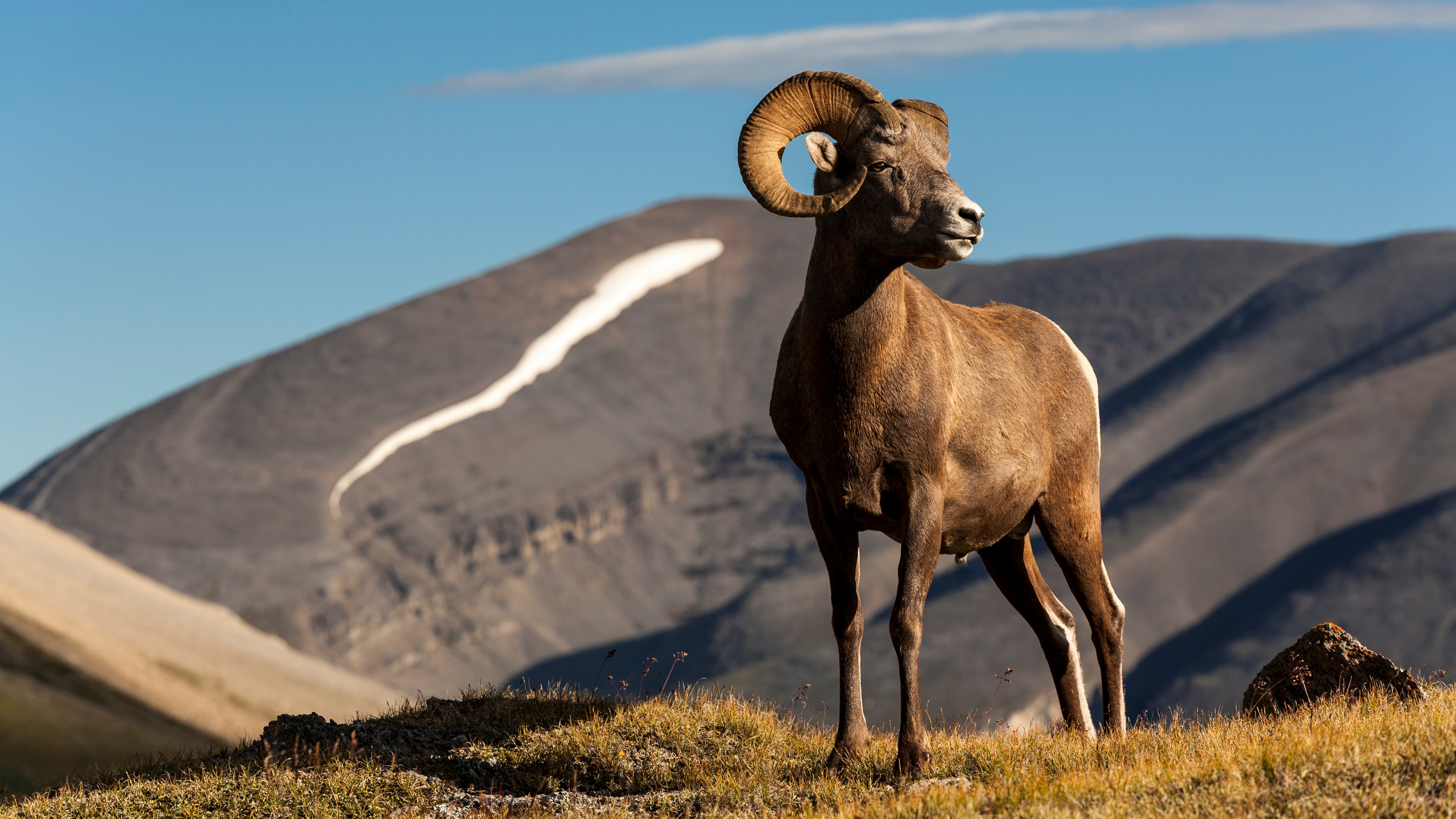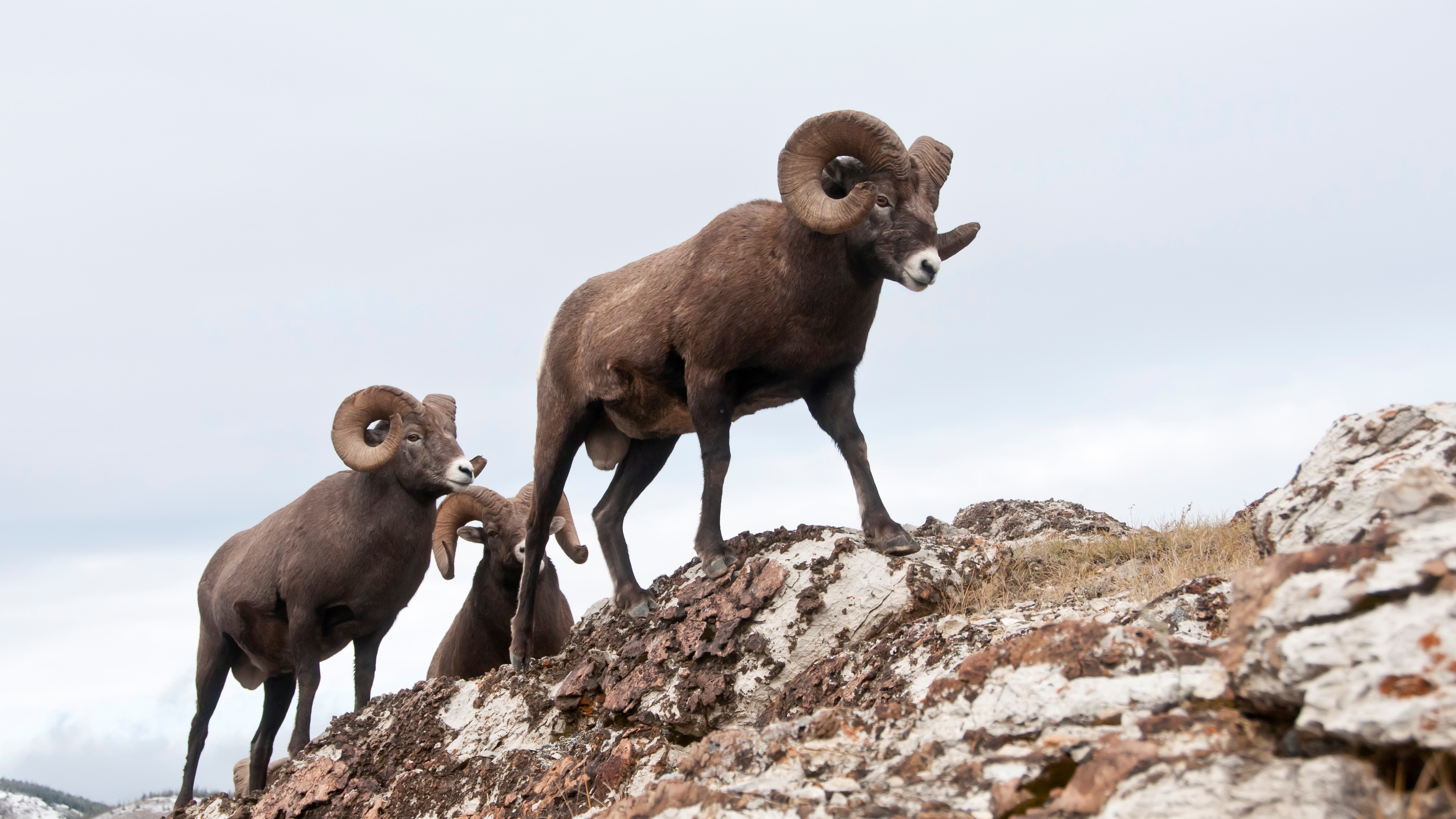Are bighorn sheep dangerous?
Do you need to be afraid of being headbutted by these cloven hooved mountain dwellers?

When you first start hiking out west, you’ll be amazed at all the wildlife you might encounter, from black bears having a tussle in the woods to massive moose quietly loitering among lodgepole pine. Virtually every mammal you might see in these mountains will inspire curiosity and a little fear (or a lot of fear if it’s a mountain lion), but what about bighorn sheep? Should you be afraid of them? The symbolism of a sheep, after all, usually represents meekness and timidity. There’s a good reason why we describe one who feels embarrassed and lacks confidence as “sheepish” and not “tigerish.” But we usually associate that imagery with the fluffy white sheep that roam around the English countryside and skitter off at any hint of an approaching hiker. The muscular bodies and giant, spiral horns of bighorn sheep might seem a different matter altogether. In this article, we cover what bighorn sheep are, where you might find them and whether or not you need to be afraid of these cloven hooved mountain dwellers.

What is a bighorn sheep?
Bighorn sheep are a type of Ovis that comprise wild sheep that live in herds in the mountains. Bighorn sheep have short brown fur rather than fluffy wool, and muscular bodies that weigh, on average, around 200lbs. Rams, however, can grow up to 350lbs and stand about 40 inches high at the shoulder. They have wide set eyes and extremely good eyesight, and arrange themselves so that they face in different directions to keep watch for predators.
Their cloven hooves allow them to climb the steep, rocky terrain where they live, but their most compelling feature is their horns. Rams sport large, curved horns and ewes have smaller versions. Rams do engage in fighting behavior by clashing their horns together at speeds of around 20mph according to National Geographic, and the noise can be heard echoing for miles around when you’re hiking in a valley.

Where do bighorn sheep live?
Bighorn sheep are found in the western mountains of North America, from Mexico all the way up through Canada. You’ll often see them on the side of the road when driving through high alpine areas, but their natural habitat is up on precarious rocky ledges where they can shelter from animals that like to prey on them – golden eagles, mountain lions and grizzly bears, primarily. In the summer months, they move up to higher elevations, so you’re more likely to see one when hiking a 14er, while in the winter they move lower down to find food.
The original population of bighorn sheep in North America was thought to number in the millions, but they were close to extinction in the early 1900s thanks to rampant hunting. A campaign to restore them in 1936 by the Boy Scouts of Arizona helped to recover their number, though there are thought to be less than 100,000 of them today and hunting is still heavily regulated.

Are bighorn sheep dangerous?
If you feel a bit silly even putting the words “sheep” and “dangerous” together in a sentence, don’t. Not because bighorn sheep are actually fiendish predators just waiting for you to trip over the laces on your hiking boots so they can pounce, but because any time you’re going out on a hike, it’s important to do your research on what wildlife you might encounter, and how you should respond. Wildlife safety is an important hiking skill and, especially in the mountainous regions of the American west, can be the difference between life and death. Not only can wildlife encounters occasionally result in an attack, but wildlife can carry diseases that may be harmful to your health. It’s a good idea to know what you might be dealing with and keep yourself, your pets and the wildlife safe.
Now, back to bighorn sheep. Are they dangerous? In a word, no, not particularly. People do occasionally get attacked by bighorn sheep, for example in 2015 a ram was euthanized for chasing golfers and attacking cars in Utah, but it’s extremely rare, according to the authors of a 2019 review on the subject.
All the latest inspiration, tips and guides to help you plan your next Advnture!

Bighorn sheep are herbivores so they’re certainly not trying to eat you, but they do have those giant horns. Both rams and ewes use their horns for fighting, according to the National Wildlife Federation, and rams are known to display more aggressive behavior and butt horns during mating season, kind of like elks during rutting season. A ram’s horns can weigh up to 30lbs so if they wanted to do you some damage, they certainly could, but they’re not known as aggressive animals at all. If you did manage to get yourself headbutted by a bighorn sheep, chances are it would hurt, and you were too close to it to begin with.
In order to keep yourself safe from bighorn sheep, the advice is easy to follow – just keep your distance and don’t try to approach or feed the wildlife, especially during mating season in the late summer and fall. If you want to enjoy these beautiful animals, bring a pair of binoculars on your next hike and do so from afar.
Julia Clarke is a staff writer for Advnture.com and the author of the book Restorative Yoga for Beginners. She loves to explore mountains on foot, bike, skis and belay and then recover on the the yoga mat. Julia graduated with a degree in journalism in 2004 and spent eight years working as a radio presenter in Kansas City, Vermont, Boston and New York City before discovering the joys of the Rocky Mountains. She then detoured west to Colorado and enjoyed 11 years teaching yoga in Vail before returning to her hometown of Glasgow, Scotland in 2020 to focus on family and writing.

